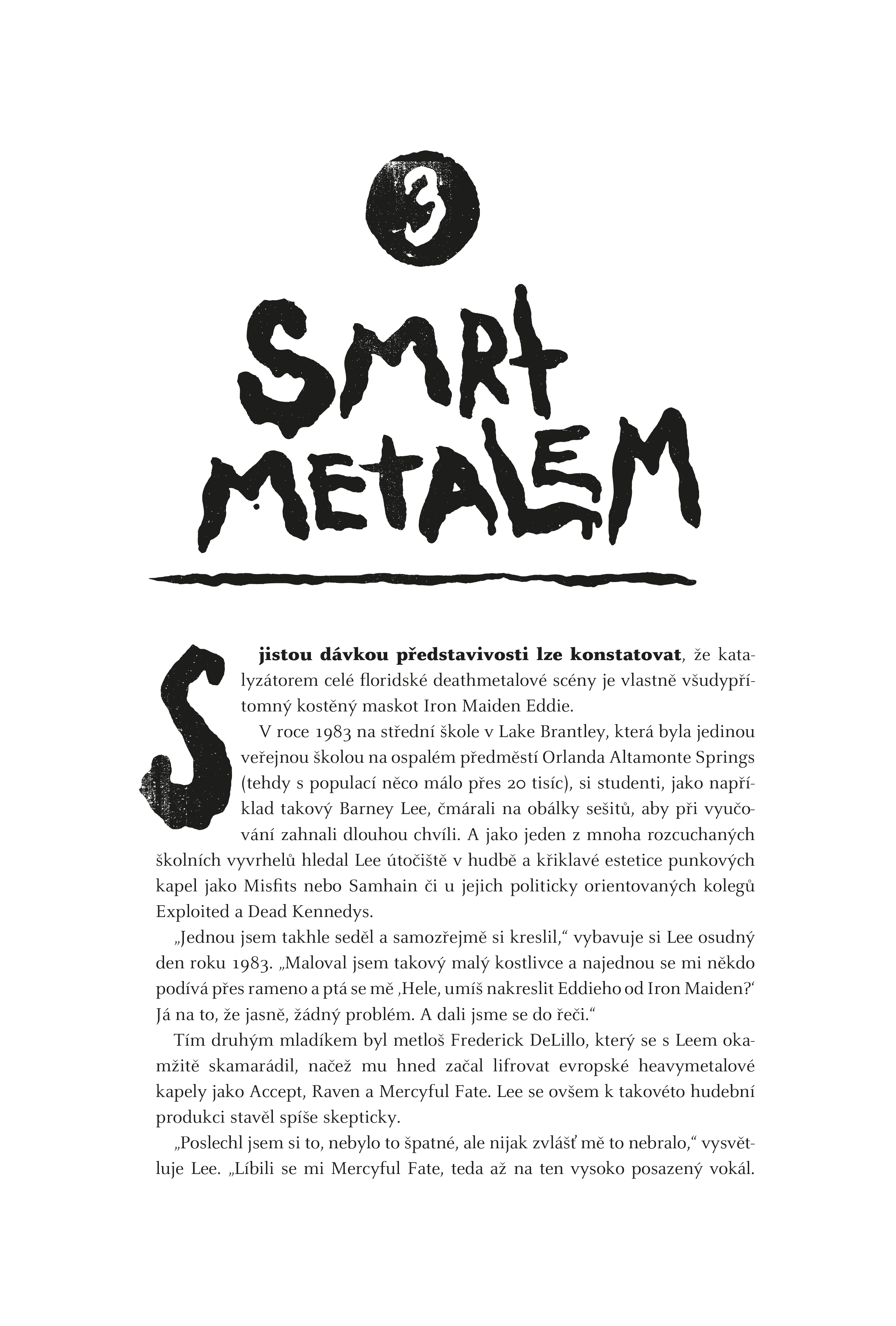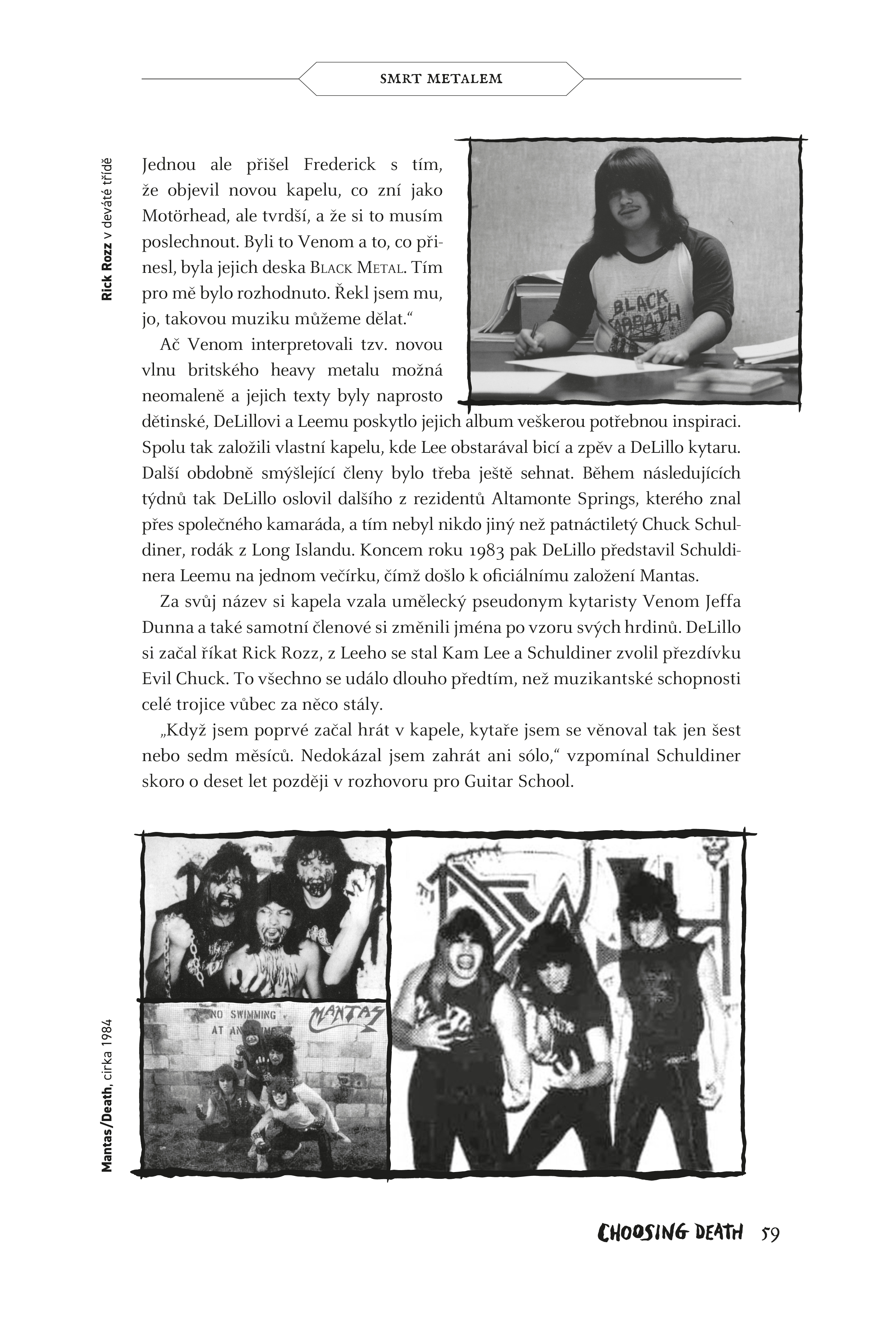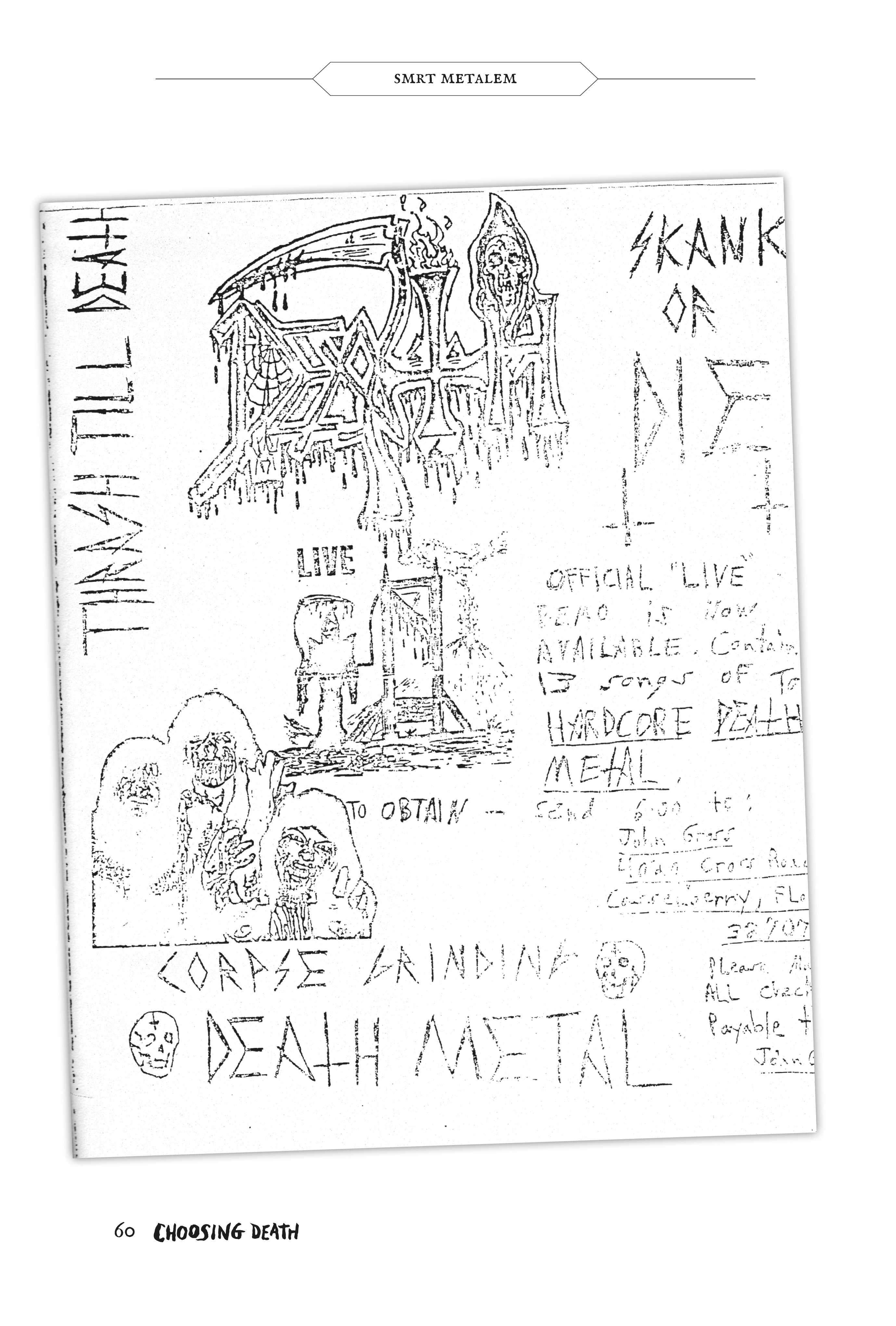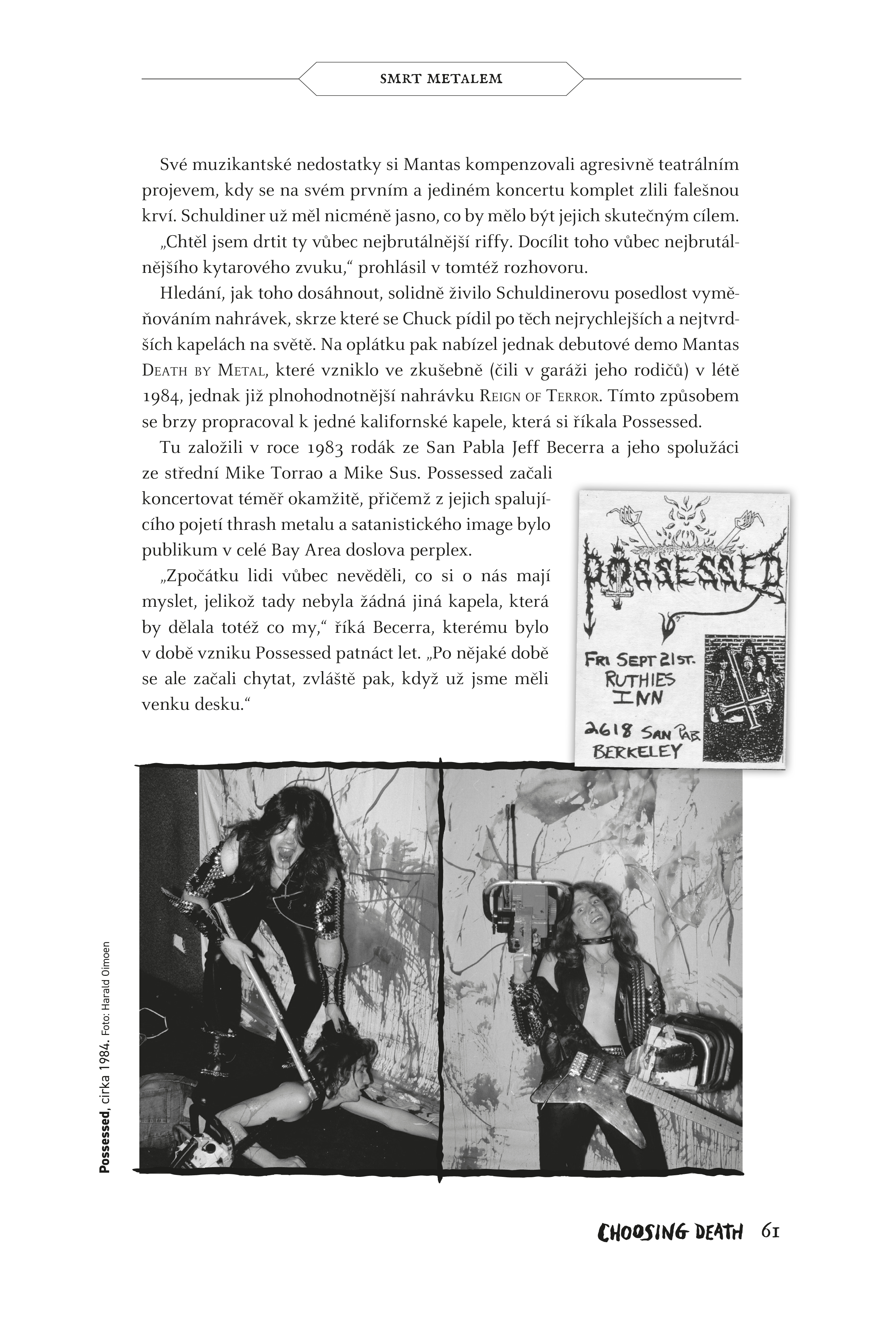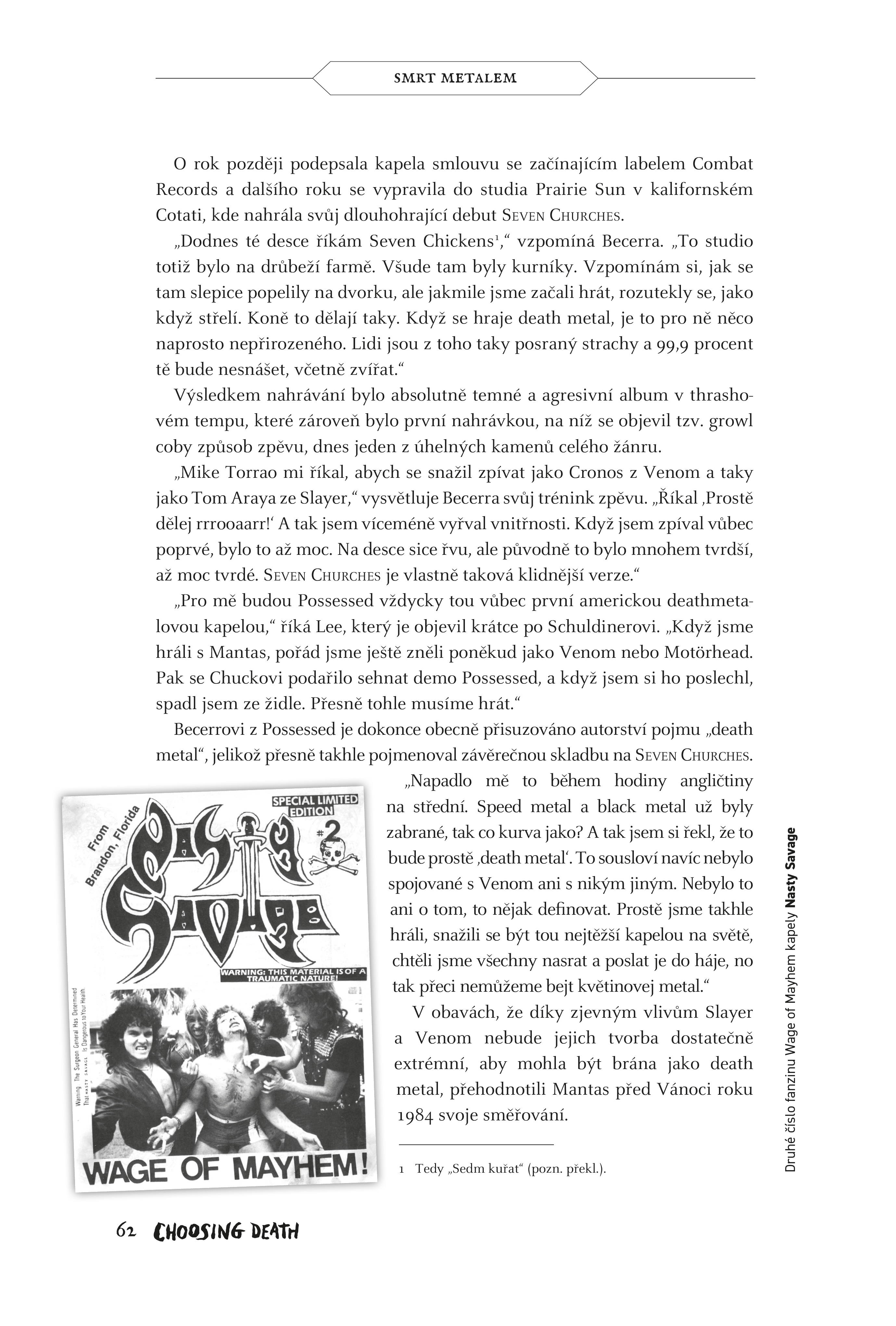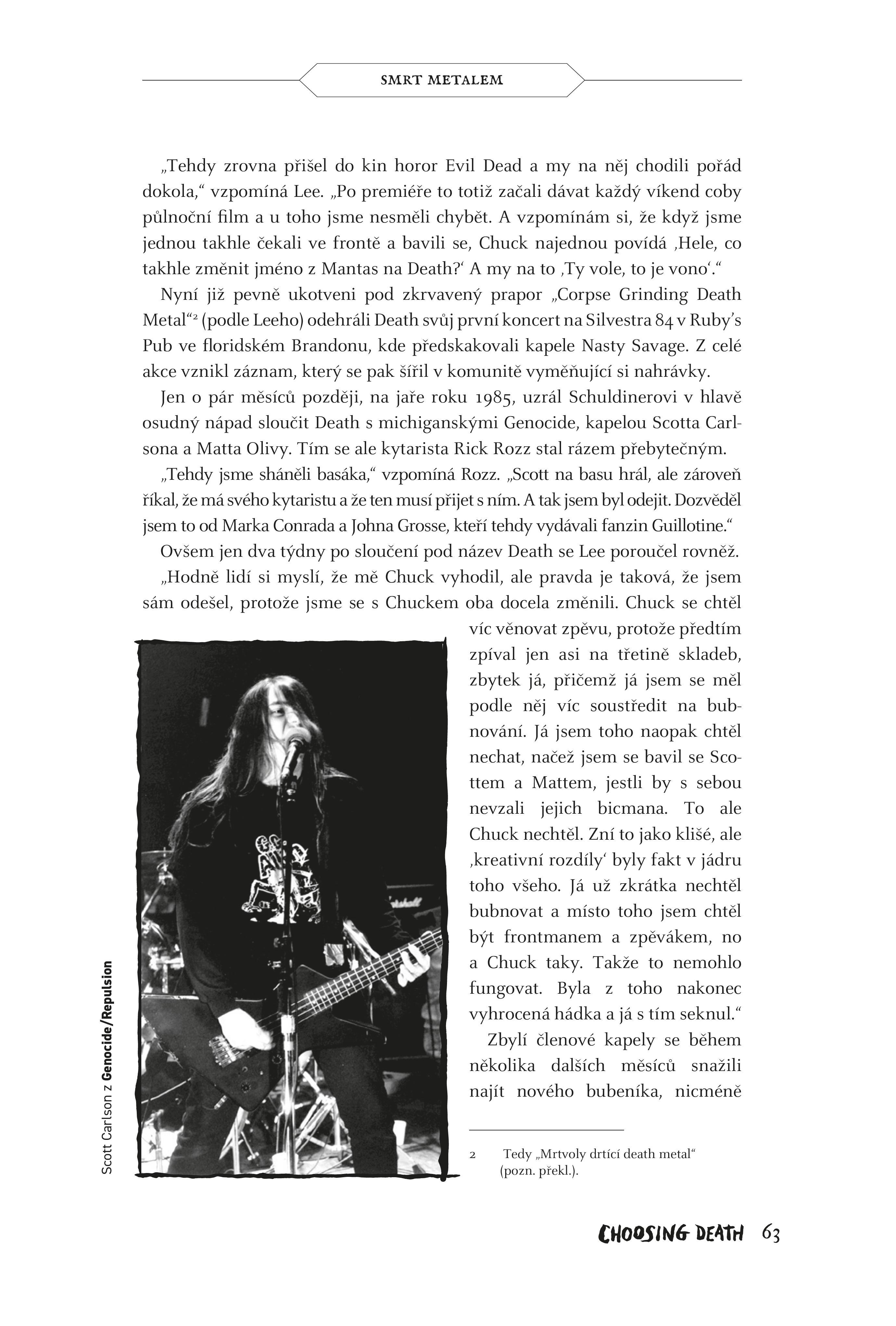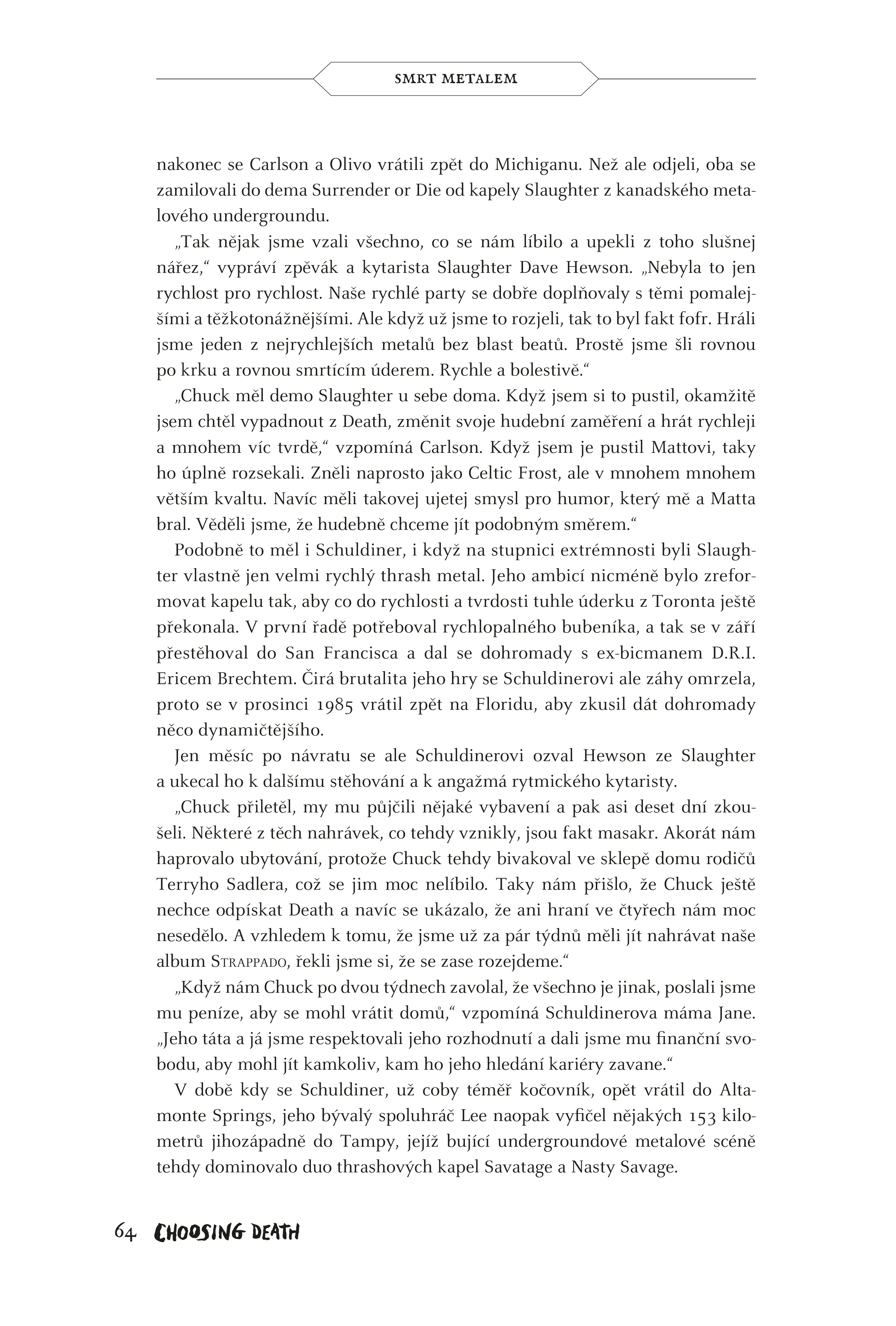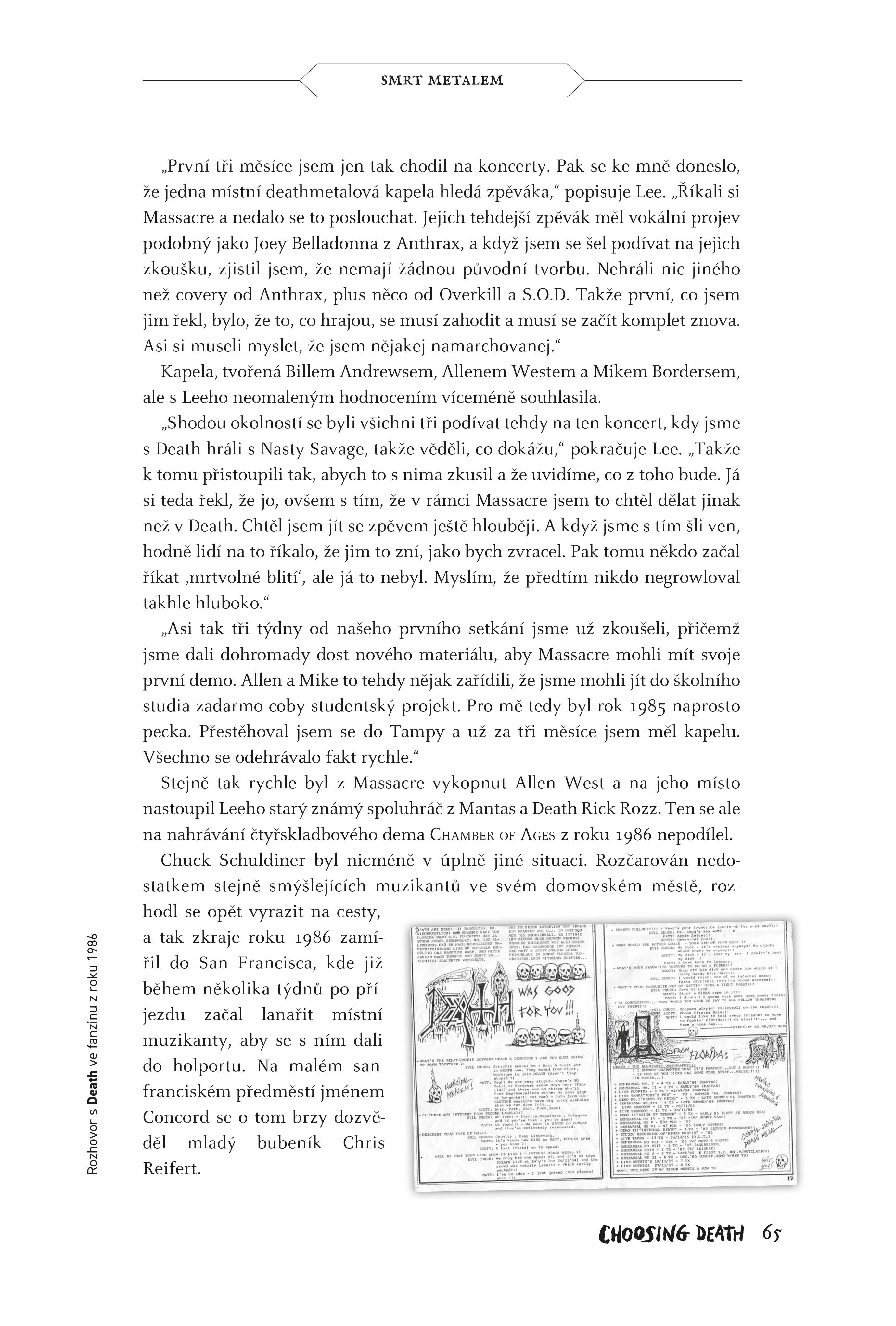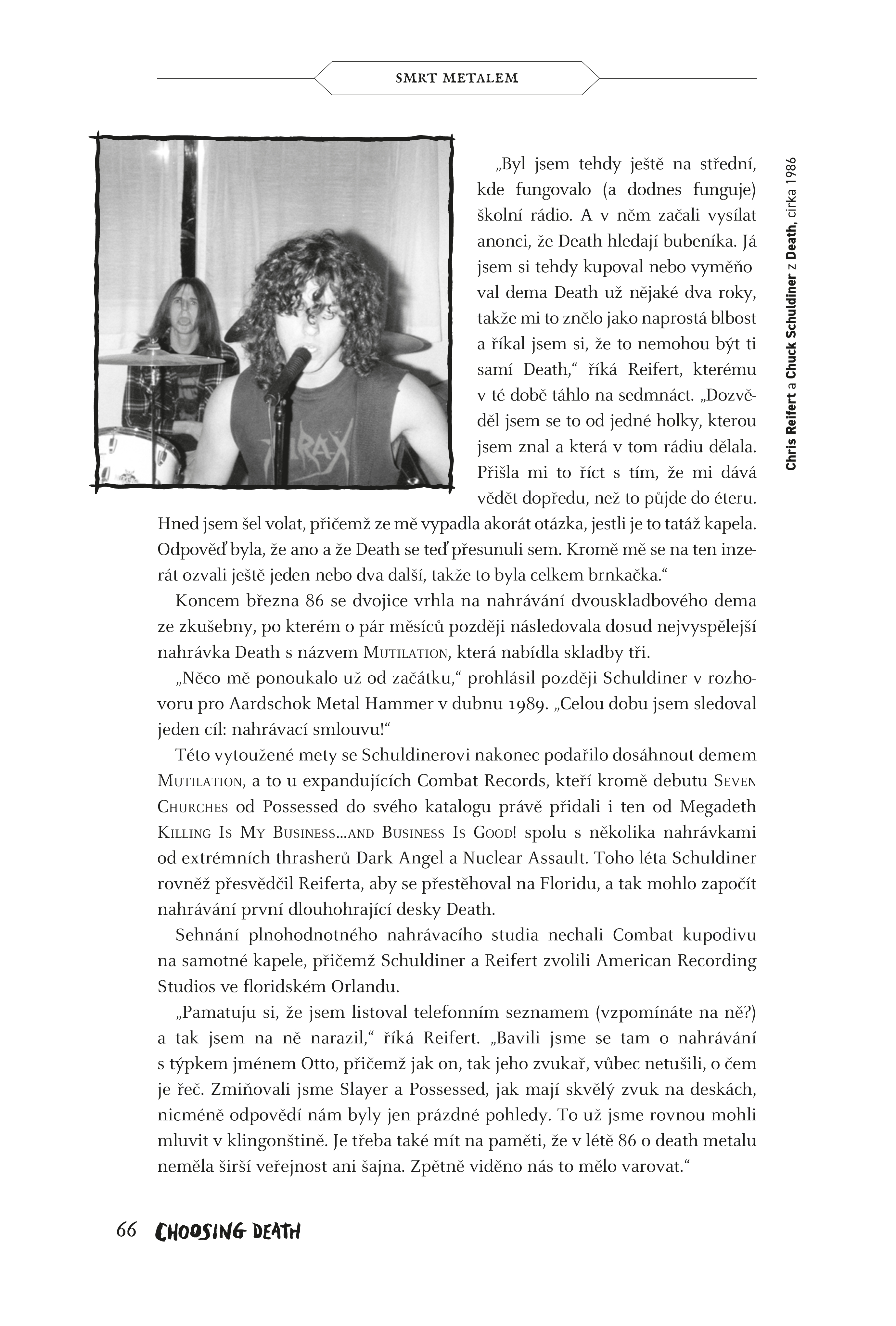Dear friends, welcome to the next installment of our coverage regarding the Czech edition of “Choosing Death: The Improbable History of Death Metal & Grindcore” by Albert Mudrian, the editor-in-chief of the iconic American metal magazine Decibel. Last time we, among other things, considered in more detail the contents of the book; today, we are following up on this subject with an excerpt!
Specifically, the sample in question comes from chapter 3, which is entitled "Death By Metal" and accounts the dawn of the Florida death metal scene, with particular focus on Mantas/Death, Morbid Angel, Executioner and R.A.V.A.G.E.
As usual, the whole excerpt is presented as it will appear in the Czech translation when printed. The layout and typesetting is by Radek Doleží (the court visual artist of Forgotten Silence). Click on the individual images to zoom.
The English original text is as follows:
With a little imagination, one could argue that Iron Maiden’s ubiquitous skeletal mascot Eddie is actually the catalyst of Florida’s entire death metal scene.
In 1983 at Lake Brantley High School, the only public school in the quiet Orlando suburb of Altamonte Springs (then with a population of just over 20,000), students like Barney Lee scribbled on notebook covers as a means of classroom distraction. Your average scraggly-haired high school pariah, Lee also sought solace in the music and garish logos of punk bands such as the Misfits and Samhain, as well as the politically minded Exploited and the Dead Kennedys.
“One day I was sitting by myself, of course, and I was doodling,” Lee recalls of that day in 1983. “I was drawing these little skeleton people, and this guy just happened to be looking over my shoulder and he said, ‘Can you draw Eddie from Iron Maiden?’ And I was like, ‘Yeah, that’s no problem.’ And then we got to talking.”
That guy was a young metalhead named Frederick DeLillo, who immediately struck up a friendship with Lee and began foisting European heavy metal acts such as Accept, Raven, and Mercyful Fate upon him. Lee, however, remained relatively skeptical of the music.
“I would listen to the stuff and I would appreciate it, but it really wasn’t my kind of thing,” he explains. “I liked the Fate, but I never liked the high-pitched vocal stuff. But one day Frederick came to me and said, ‘I got this band you’ve gotta listen to. It’s like Motörhead, but even more extreme.’ And he happened to bring in Black Metal from Venom, and that sealed it for me. I was like, ‘Yes, we can do music like this.’”
Venom’s musical interpretation of the New Wave of British Heavy Metal may have been crude, and their lyrics utterly juvenile, but that was all the inspiration DeLillo and Lee needed. The pair formed a band of their own, with Lee handling the drums and vocals, while DeLillo provided the guitar. The band still required more like-minded members. Within weeks, DeLillo had contacted a fellow Altamonte Springs resident—the Long Island–born 15-year-old guitarist Chuck Schuldiner, whom DeLillo had recently met through a mutual metal friend. When DeLillo introduced Lee to Schuldiner at a party in late 1983, Mantas was officially born.
Lifting their nomenclature from the stage moniker of Venom guitarist Jeff Dunn, the youngsters similarly altered their own names—DeLillo becoming Rick Rozz, Lee shifting to Kam Lee, and Schuldiner adopting Evil Chuck—well before becoming proficient musicians.
“When I first started the band,” Schuldiner told Guitar School nearly a decade later, “I’d only been playing guitar for six or seven months—I couldn’t even play a lead.”
The group compensated for their musical deficiencies by developing an aggressive theatrical element to Mantas, covering themselves in fake blood for their first and only official live performance, but their true objective remained clear to Schuldiner.
“My main goal was to bash out the most brutal riffs ever,” he said in that same interview, “with the most brutal guitar sound ever.”
That search helped foster Schuldiner’s growing obsession with tape-trading. Armed with dubbed copies of both Mantas’s debut rehearsal demo Death by Metal (recorded in his parents’ garage during the summer of 1984) and the band’s October ’84 “proper” demo, Reign of Terror, Schuldiner set out to uncover the fastest, heaviest band in the world. Soon he discovered the demo of a California band called Possessed.
Formed by San Pablo native Jeff Becerra along with junior high school friends Mike Torrao and Mike Sus in 1983, Possessed began gigging almost immediately, perplexing Bay Area audiences with a blistering take on thrash metal and an overtly Satanic image.
“At first, people didn’t know what to think, because there really weren’t any other bands doing the kind of thing we were doing,” says Becerra, just 15 years old at the start of the band. “After a while, people started to catch on, especially by the time we had a record out to sell them.”
In 1984, Possessed signed a recording contract with the fledging Combat Records label, and a year later set out to Prairie Sun Studios in Cotati, California, to record their debut LP, Seven Churches.
“To this day, I still refer to that album as ‘Seven Chickens,’” Becerra explains. “The studio was on a chicken ranch. Most of them were in chicken coops. And I remember they were running around, and when you’d actually start playing, they’d go to the other side of the yard. Horses will do that, too, when you play death metal—it’s like completely unnatural to them. Death metal scares the fuck out of people, too, and 99.9 percent will hate you, animals included.”
The result was an overly dark and violent thrash-paced album, which was the first proper LP to feature what would become the standard growling death metal vocals for the genre.
“Mike Torrao said, ‘Try to be like Cronos from Venom and try to be like Slayer’s Tom Araya,’” recalls Becerra of his vocal coaching. “He said, ‘Just go rrrooaarr!’ So I pretty much just yelled my guts out. The first time I ever sang, it sounded too heavy. I’m yelling on Seven Churches, but it was really much heavier than that; it was just too much. So Seven Churches is really a calmed down version of the earlier stuff.”
“To me, Possessed is still the first American death metal band,” offers Lee who discovered the band shortly after Schuldiner. “When we were in Mantas, we still had a more Venom/Motörhead sound kinda going on. And then I
remember Chuck getting the Possessed demo and I just remember hearing it and just freaking out, like, ‘Man, this is the way we gotta be.’”
Possessed’s Becerra, in fact, is widely credited with actually coining the term “death metal,” writing Seven Churches’ closing song, simply titled “Death Metal.”
“I came up with that during an English class in high school,” the bassist/vocalist explains. “I figured speed metal and black metal were already taken, so what the fuck? So I said ‘death metal’ because that word wasn’t associated with Venom or anybody else. It wasn’t even about redefining it. We were playing this music and we were trying to be the heaviest thing on the face of the planet. We wanted just to piss people off and send everybody home. And that can’t be, like, flower metal.”
Fearing their obvious Slayer and Venom influences were no longer extreme enough to be considered death metal, the Mantas members reevaluated their approach just before that Christmas.
“I remember the movie Evil Dead had just come to theaters, and we were going constantly,” says Lee. “First, Evil Dead premiered at the theater, and then they started playing it as a midnight movie every weekend and we were going, like, every weekend. And I remember we were standing in line all talking, and Chuck said, ‘Why don’t we just change the name of the band from Mantas to Death?’ And we were like, ‘That’s perfect.’”
Now categorized more specifically, according to Lee, under the blood-soaked banner of “Corpse Grinding Death Metal,” the band played its first gig as Death opening for thrashers Nasty Savage at Ruby’s Pub in Brandon, Florida, on New Year’s Eve 1984. The show was recorded and circulated throughout the tape-trading underground.
Just a few months later, in the spring of ’85, Schuldiner hatched an ill-fated plan to merge forces with Scott Carlson and Matt Olivo of Michigan metallers Genocide. Unfortunately, the new arrangement made guitarist Rick Rozz a victim of redundancies.
“We were trying to find a bass player,” Rozz recalls. “Scott was playing bass and said that he had a guitar player, and his guitar player had to come with him. So I was let go. Mark Conrad and John Gross, the two editors of that Guillotine fanzine from back in the day, they were the ones that told me I was out.”
Within only two weeks of uniting under the Death moniker, Lee exited the new group as well.
“A lot of people think Chuck kicked me out, but the truth is I quit because me and Chuck started being a little bit different,” Lee contends. “Chuck wanted to step in and sing more songs because at the time, Chuck was only singing about a third of the songs, and I was doing the vocals. He said he wanted me to concentrate more on drums. And the fact is, at that time, I wanted to step down from drumming, and I was talking to Scott and Matt about maybe getting their old drummer to move down, and Chuck didn’t wanna do that. You hear it all the time, but ‘creative differences’ is exactly what it was. Pretty much the basis of the whole thing was that I no longer wanted to play drums. I wanted to become a frontman and vocalist, and Chuck wanted to also be a vocalist. That wasn’t gonna work. And it turned into a heated argument, and basically I ended up quitting.”
The remaining band members spent the next few months trying to find a proper drummer, but eventually Carlson and Olivo returned home to Michigan. Before they left, however, the pair became enamored with the Surrender or Die demo recording from underground Canadian metal band Slaughter.
“We took a little of everything we loved, and we grinded out some of the heaviest shit around,” offers Slaughter guitarist/vocalist Dave Hewson. “Not just speed for the sake of speed, but our fast parts worked well off of our slower, heavier parts. But I must say that when we played fast, we played fast. It was some of the fastest metal with no blast beats. We just went right for the throat and in for the kill—fast and painful.”
“Chuck had the Slaughter demo at his house. I put it on and immediately wanted to stop playing with Death and just change my musical direction and go faster and harder,” recalls Carlson. “When I played it for Matt, he too was like, ‘Oh my God, these guys are amazing.’ It was total Celtic Frost, but much, much faster. They had this wicked sense of humor that Matt and I were both totally into. We just said that we wanted to do something more like this.”
In terms of extremity, Slaughter may have been only a very fast thrash metal band, but Schuldiner was equally captivated with the group, and set out to start a band of his own that was even faster and heavier than the Toronto based outfit. Requiring a rapid-fire drummer, Schuldiner moved to San Francisco in September, teaming up with ex-D.R.I. drummer Eric Brecht. After recording only a single rehearsal demo with Brecht, Schuldiner quickly grew weary of the union’s unadulterated brutality and returned to Florida by December of ’85 in hopes of developing a more dynamic outfit.
Only a month after his Florida homecoming, however, Schuldiner made contact with Slaughter’s Hewson, who convinced the young frontman to relocate yet again and join his band as rhythm guitarist.
“Chuck flew up and we rented him some gear, and we rehearsed for about ten days,” recalls Hewson. “Some of the tapes we made were fucking heavy. The living arrangements were not working out, though, as Chuck was living in Terry Sadler’s parents’ basement—not to their liking. We also felt Chuck was not ready to retire Death, nor were we totally comfortable being a fourpiece. With the recording of our album Strappado only a few weeks away, it was decided to part ways.”
“When Chuck called after two weeks to tell us of his change in plans, we wired the money to him to fly home,” recalls Schuldiner’s mother Jane. “His father and I respected his decisions and gave him financial freedom to go wherever his search led him for his career.”
By the time the nearly nomadic Schuldiner returned home to Altamonte Springs, his former bandmate Lee had departed 95 miles southwest to Tampa, where the thrash tandem of Savatage and Nasty Savage led the city’s burgeoning underground metal scene.
“I was there about three months just going to shows, and I got word that this death metal band was looking for a vocalist,” Lee explains. “It happened to be this band called Massacre and it was just horrible. The vocalist that they had was more or less this vocalist kinda like Anthrax’s Joey Belladonna. When I’d gone to the rehearsal, they pretty much had no originals at all. They were playing Anthrax covers and a couple Overkill songs and some S.O.D. songs. And the first thing I said—I guess I came off kinda cocky—was, ‘Look, if you guys want me to sing, this stuff that you’re playing now has gotta go. You just gotta completely start over from scratch.’”
The band, rounded out by Bill Andrews, Allen West, and Mike Borders, generally agreed with Lee’s blunt appraisal.
“These guys had come to that show when Death had played with Nasty Savage, so they knew what I could do,” Lee continues. “So they said, ‘Try it out and see what you think of us.’ So when it came to Massacre, I said, ‘I wanna step away from what I was doing in Death; I wanna go even deeper with my voice.’ And when that came out, a lot of people said, ‘God, that sounds like you’re vomiting.’ And it got nicknamed ‘death vomit vocals,’ but I never came up with that. Before that, I don’t think anyone was growling that deep.
“Probably three weeks after that initial meeting, we were just practicing, and we had enough material to put out the first Massacre demo,” Lee continues. “At the time, Allen and Mike both had some kind of hook where we could go into a student project studio for free. So 1985 was like ‘boom!’ I moved to Tampa, I was there three months and I was already in a band. It happened really fast.”
Just as quickly, Allen West was given the boot by Andrews and replaced by Lee’s old Mantas/Death bandmate Rick Rozz, though he wouldn’t record with the group until their four-song Chamber of Ages demo in 1986.
Chuck Schuldiner, however, was in a much different situation. Disillusioned with the dearth of like-minded musicians in his hometown, he decided again to relocate to San Francisco in early 1986. Within a few short weeks of his arrival, Schuldiner began actively courting local musicians to play with him. In the small San Francisco suburb of Concord, a young drummer named Chris Reifert soon got the word.
“I was in high school still and they had—and still do—a high school radio station, and they were about to place an ad for Death looking for a drummer, which was insane, because I had been buying and trading Death demos for the past year or two and thought, like, ‘No way, it couldn’t be the same Death,’” says Reifert, about to turn 17 at the time. “And I knew this girl who worked at the radio station and she said, ‘Hey, we’re gonna run this ad and I thought I’d tell you about it before I ran it.’ So I called up—I think even before it was on the air—and I just said, ‘Is this the same band?’ And they said, ‘Yep, we’re just over here now.’ I was one out of either one or two calls that he received, so it was pretty much a cinch.”
The pair immediately recorded a two-song rehearsal tape late in March of 86 before quickly following it up with the band’s most polished material in the form of the three-track Mutilation demo several months later.
“Something teased me from the very start,” Schuldiner later told Aardschok-Metal Hammer in April of 1989. “All the time I kept one main goal: a record deal!”
Mutilation did earn Schuldiner that elusive recording contract with the expanding Combat Records, who in addition to Possessed’s Seven Churches, had recently released Megadeth’s Killing Is My Business…and Business Is Good! debut, as well as LPs
from extreme thrashers Dark Angel and Nuclear Assault. That summer Schuldiner convinced Reifert to relocate to Florida to record Death’s debut album.
Curiously, Combat entrusted the young pair with securing a proper recording studio to track their label debut. Schuldiner and Reifert quickly landed in Orlando at a place called American Recording Studios.
“I remember flipping through the phone book—remember those?—and finding it that way,” says Reifert. “We spoke with a guy named Otto about our project, and he and the engineer really had no clue what we were talking about. We were going on about Slayer and Possessed and how they had great-sounding records, and we got blank looks in return. We might as well have been speaking Klingon. Keep in mind, this was summer of ’86 and death metal was still unheard of, as far as the general public went. That should have been a warning sign, in retrospect.”
So, enjoy and more next time!
P.S.: Further info in the current press release here.







